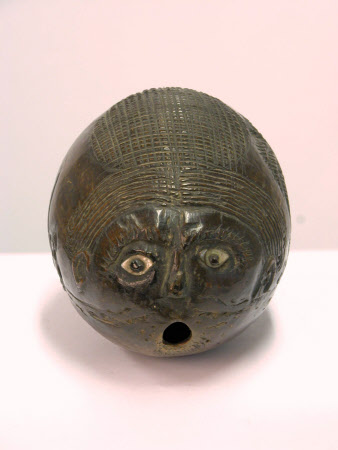Coconut shell carved in the form of a face
Category
Art / Sculpture
Date
Unknown
Materials
Coconut, seashell, wood
Measurements
90 mm (Height) x 85 mm (Depth); 130 mm (Length)
Place of origin
Papua New Guinea
Order this imageCollection
Greenway, Devon
NT 120521
Summary
Coconut shell, seashell, wood, a container in the form of a face, Papua New Guinea, 19th or 20th century. A carved coconut shell container made in Papua New Guinea. The three ‘eyes’ of the coconut form two anthropomorphic eyes and an open gaping mouth. The two eyes have shell insertions held in place by wood, and are surrounded by lightly incised carving, suggestive of eyelashes or eyebrows. A delicately carved nose and two ears are visible. Further decorative carved lines and crosshatch patterns represent hair. Previously attributed to the Elema Region of the Papuan Gulf.
Full description
The coconut is widely used for utility, food, and ceremony in many communities across Papua New Guinea. This coconut may have been intended for use as a water container or lime vessel. Lime powder is chewed together with betel leaves and areca nut to produce a mild narcotic effect similar to tobacco. Betel chewing equipment displays a variety of decorations, but this container has fewer stylistic similarities or clan-based patterns than expected for betel chewing equipment in Papua New Guinea. This container was previously catalogued as a ‘Charm coconut inlaid with bone (wood), carved as a pig's head, Elema people, Gulf of Papua, 19th/20th century.’ The Elema people of the Gulf Province in Papua New Guinea are known for the creation of magical charms known as marupai. Marupai were worn around the neck in a small basket and carried by initiated men, and some women. The charms protected their owners, assisted in hunting, or killed enemies. As Jennifer Newell describes, ‘[t]he making and the design of this object is highly complex. To make a 'marupai' such as this, a carver would soften a dwarf coconut in water and enlarge the holes at the point, to create a nose and mouth resembling an animal (pig or crocodile)’ (Newell 2011, p. 53). It is unlikely that the former attribution of a charm from the Elema people is accurate unless this charm was created less in the sense of traditional Papuan art, which is religious in nature, and perhaps instead created as an object for onward sale. Stylistically the container displays a human-like carved face and is lacking the usual clan-based carved patterns of a ceremonial object. This may be due to its more practical function as a water container.
Provenance
Given with the contents Greenway to the National Trust by Mrs Rosalind Hicks (d. 2004), Anthony Hicks (d. 2005) and Mathew Prichard in 2006, and accepted in 2007.
References
Newell 2011: Jennifer Newell, Pacific Art in Detail, The British Museum Press, London 2011 Lewis 1931: Albert Buell Lewis, Carved and Painted Designs from New Guinea, Chicago 1931
